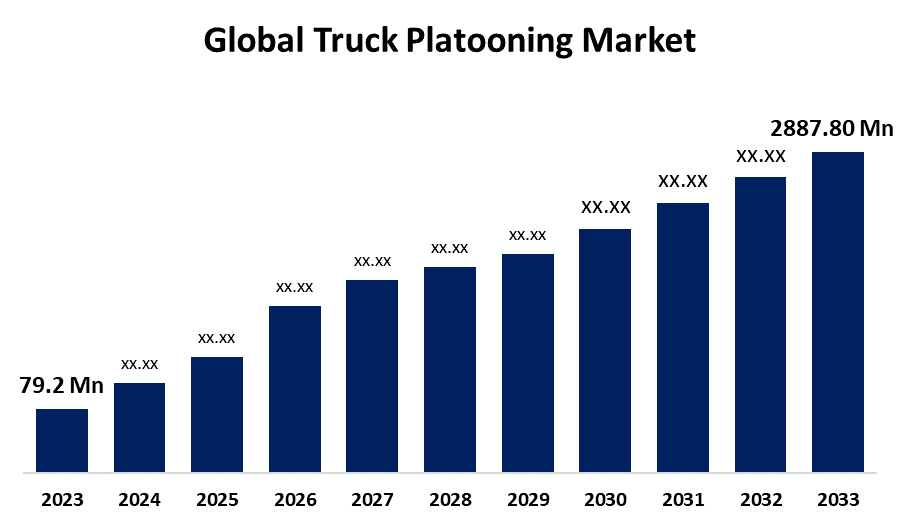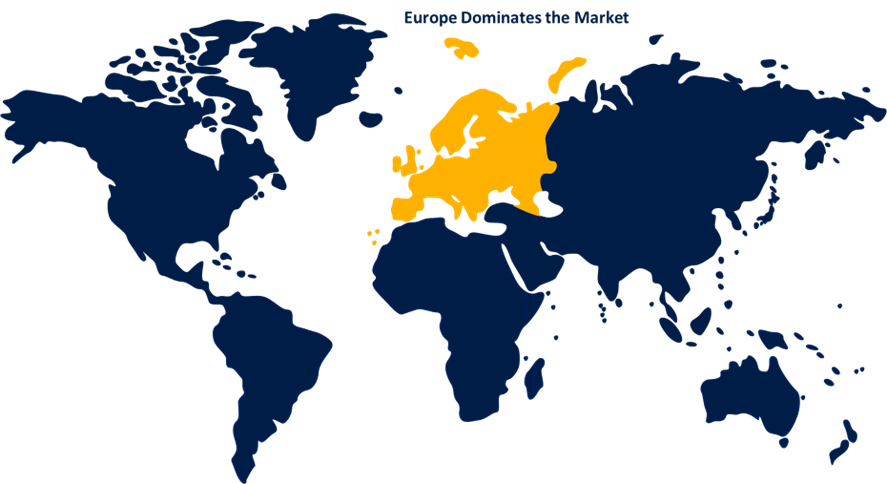Global Truck Platooning Market Size, Share, and COVID-19 Impact Analysis, By Technology Type (Vehicle-to-Vehicle Communication, Autonomous Control System, Human Intervention System), By Platooning Type (Supported Platooning, Autonomous Platooning), By Level of Autonomy (Semi-autonomous, Fully Autonomous), and By Region (North America, Europe, Asia-Pacific, Latin America, Middle East, and Africa), Analysis and Forecast 2023 - 2033
Industry: Automotive & TransportationGlobal Truck Platooning Market Insights Forecasts to 2032
- The Global Truck Platooning Market Size was valued at USD 79.2 Million in 2023.
- The Market Size is growing at a CAGR of 43.28% from 2023 to 2033
- The Worldwide Truck Platooning Market Size is expected to reach USD 2887.80 Million by 2033
- North America Market is expected to grow the fastest during the forecast period

Get more details on this report -
The Global Truck Platooning Market Size is anticipated to exceed USD 2887.80 Million by 2033, growing at a CAGR of 43.28% from 2023 to 2033.
Market Overview
Truck platooning is the process of linking two or more trucks in a group using connectivity technology and an automated driving support system. The connectivity technology enables vehicles to accelerate and brake simultaneously while maintaining a predetermined, close distance between them. The truck at the head of the platoon serves as a leader, while the remaining trucks adapt to changes in their movement. The drivers may also choose to leave the platoon and drive independently. Truck platooning improves transportation by using roads more efficiently, reducing traffic congestion, and delivering goods more quickly. The market is divided into two platooning types: autonomous truck platooning and driver-assistive truck platooning (DATP). According to the system, the market is divided into five segments: adaptive cruise control, automated emergency braking, blind spot warning, forward collision warning, and others. The truck platooning market is expanding rapidly and is expected to continue to do so in the years ahead. Truck platooning is a concept in which two or more trucks travel in a closely spaced convoy using advanced connectivity and automation technology. These technologies allow the trucks to communicate with one another and operate in sync. The lead truck sets the pace, and the following trucks keep a safe distance while benefiting from reduced air drag and increased fuel efficiency.
Report Coverage
This research report categorizes the market for the global truck platooning market based on various segments and regions forecasts revenue growth and analyzes trends in each submarket. The report analyses the key growth drivers, opportunities, and challenges influencing the global truck platooning market. Recent market developments and competitive strategies such as expansion, product launch, and development, partnership, merger, and acquisition have been included to draw the competitive landscape in the market. The report strategically identifies and profiles the key market players and analyses their core competencies in each sub-segment of the global truck platooning market.
Global Truck Platooning Market Report Coverage
| Report Coverage | Details |
|---|---|
| Base Year: | 2023 |
| Market Size in 2023: | USD 79.2 Million |
| Forecast Period: | 2023-2033 |
| Forecast Period CAGR 2023-2033 : | 43.28% |
| 2033 Value Projection: | USD 2887.80 Million |
| Historical Data for: | 2019-2022 |
| No. of Pages: | 200 |
| Tables, Charts & Figures: | 110 |
| Segments covered: | By Technology Type, By Platooning Type, By Level of Autonomy, By Region |
| Companies covered:: | AB Volvo, Daimler, Scania, Peloton Technology, Continental AG, Volkswagen AG, Wabco, Navistar, Inc., MAN, ZF Friedrichshafen AG, Bendix Commercial Vehicles Systems LLC, Eaton, and Other Key Vendors. |
| Pitfalls & Challenges: | COVID-19 Empact,Challenges, Future, Growth, & Analysis |
Get more details on this report -
Driving Factors
Truck platooning provides essential fuel savings, which is a major motivator for its adoption. Lower fuel consumption means lower operational costs for fleet operators, and the need to reduce greenhouse gas emissions and meet sustainability goals encourages the use of environmentally friendly transportation solutions such as truck platooning. Continuous advancements in vehicle-to-vehicle communication, sensor technologies, and automated driving systems boost the growth of the truck platooning market. Governments all over the world are encouraging truck platooning through supportive regulations, incentives, and funding programs, thereby boosting market growth. The trucking industry is constantly striving to improve truck fleet efficiency to make long-distance deliveries more cost-effective. Platooning optimizes transportation by making better use of the roads, allowing logistics companies to deliver goods more quickly. Additionally, effective road utilization reduces traffic jams. Platooning technology allows trucks to form road trains by traveling closely together in a single file, significantly reducing air drag and improving fuel economy. All of these factors increase the efficiency of trucking operations, which fuels the demand for truck platooning.
Restraining Factors
Truck platooning requires adequate infrastructure, such as dedicated lanes, intelligent transportation systems, and supportive policies. The lack of infrastructure is an obstacle to market expansion. Truck platooning systems require significant upfront investment, which could hamper small and medium-sized fleet operators. Furthermore, truck platooning technology may face opposition from truck drivers who are concerned about job displacement or doubt the dependability and safety of automated systems.
Market Segmentation
The global truck platooning market share is classified into technology type, platooning type, level of autonomy, and end-user.
- The vehicle-to-vehicle communication segment is expected to grow fastest in the global truck platooning market during the forecast period.
The global truck platooning market is categorized by technology type into vehicle-to-vehicle communication, autonomous control systems, and human intervention systems. Among these, the vehicle-to-vehicle communication segment is expected to grow fastest in the global truck platooning market during the forecast period. The global truck platooning market is comprised of three segments: vehicle-to-vehicle communication (V2V), autonomous control system (ACS), and human intervention system (HIS). Trucks can communicate with one another using V2V technology, allowing them to maintain a safe distance and speed while reducing fuel consumption, pollution, and traffic congestion. The demand for advanced driver assistance systems (ADAS) is growing, as is the need to reduce fleet management's carbon footprint and operating costs. The V2V system is a cost-effective option for fleet managers because it is simple to implement and requires no significant changes to existing vehicle infrastructure.
- The supported platooning segment is expected to grow at the highest pace in the global truck platooning market during the forecast period.
Based on the platooning type, the global truck platooning market is divided into supported platooning and autonomous platooning. Among these, the supported platooning segment is expected to grow at the highest pace in the global truck platooning market during the forecast period. supported platooning is a type of platooning in which the driver maintains control of the vehicle while the platooning system keeps the cars in the platoon at a safe distance and speed. This type of platooning is becoming increasingly popular due to its benefits in terms of fuel efficiency and reduced carbon emissions. Supported platooning is more user-friendly than autonomous platooning because it requires less technological development and allows the driver to maintain control of the vehicle. The desire to reduce transportation costs, the popularity of smart transportation systems, and the growing demand for environmentally friendly and fuel-efficient vehicles are all driving the global truck platooning market.
- The semi-autonomous segment is expected to hold the largest share of the global truck platooning market during the forecast period.
Based on the level of autonomy, the global truck platooning market is divided into semi-autonomous, and fully autonomous. Among these, the semi-autonomous segment is expected to hold the largest share of the global truck platooning market during the forecast period. It is an electrical protection device that prevents lightning strikes and other power surges. These arresters are installed on substations to protect equipment from voltage surges caused by lightning strikes, system faults, and switching surges, as well as the growing demand for electric power transmission services in a variety of industries. The growing need for energy infrastructure development in emerging countries are expected to drive growth in this market segment.
Regional Segment Analysis of the Global Truck Platooning Market
- North America (U.S., Canada, Mexico)
- Europe (Germany, France, U.K., Italy, Spain, Rest of Europe)
- Asia-Pacific (China, Japan, India, Rest of APAC)
- South America (Brazil and the Rest of South America)
- The Middle East and Africa (UAE, South Africa, Rest of MEA)
Europe is anticipated to hold the largest share of the global truck platooning market over the predicted timeframe.

Get more details on this report -
Europe is projected to hold the largest share of the global truck platooning market over the predicted years. The presence of major trucking companies like Daimler, MAN, and others has boosted market growth in the region. For instance, most truck platooning technology providers, including Volvo, Daimler, Scania, MAN, and others, are headquartered in Europe. Furthermore, the ENSEMBLE project intends to implement multi-brand truck platooning in Europe to improve fuel efficiency and traffic safety, which is expected to drive market growth. Furthermore, European safety standards are more stringent than any other country. All trucks in Europe have been required to have advanced emergency braking and lane-keeping assistance. All of these factors will contribute to market growth during forecast period.
Asia-Pacific is expected to grow fastest in the global truck platooning market during the forecast period.The rapidly expanding trucking industry, combined with the strong presence of manufacturing and logistics sectors in emerging economies such as India, China, and others, is expected to influence regional commercial vehicle platooning adoption. Furthermore, APAC has the highest volume of truck sales of any region. As such, the widespread availability of truck fleets and advanced trucking technologies developed by key players operating in China, Japan, and India are expected to drive market growth over the forecast period.
Competitive Analysis
The report offers the appropriate analysis of the key organizations/companies involved in the global truck platooning along with a comparative evaluation primarily based on their product offering, business overviews, geographic presence, enterprise strategies, segment market share, and SWOT analysis. The report also provides an elaborative analysis focusing on the current news and developments of the companies, which includes product development, innovations, joint ventures, partnerships, mergers & acquisitions, strategic alliances, and others. This allows for the evaluation of the overall competition within the market.
List of Key Companies
- AB Volvo
- Daimler
- Scania
- Peloton Technology
- Continental AG
- Volkswagen AG
- Wabco
- Navistar, Inc.
- MAN
- ZF Friedrichshafen AG
- Bendix Commercial Vehicles Systems LLC
- Eaton
- Others
Key Target Audience
- Market Players
- Investors
- End-users
- Government Authorities
- Consulting And Research Firm
- Venture capitalists
- Value-Added Resellers (VARs)
Recent Developments
- In June 2023, TuSimple, a global autonomous driving technology company, started testing its level 4 autonomous vehicles. The test run began in Japan's critical freight corridor. The freight corridor connects major Japanese cities like Nagoya, Osaka, and Tokyo.
Market Segment
This study forecasts revenue at global, regional, and country levels from 2022 to 2033. Spherical Insights has segmented the Global Truck Platooning Market based on the below-mentioned segments:
Global Truck Platooning Market, By Technology Type
- Vehicle-to-Vehicle Communication
- Autonomous Control System
- Human Intervention System
Global Truck Platooning Market, By Platooning Type
- Supported Platooning
- Autonomous Platooning
Global Truck Platooning Market, By Level of Autonomy
- Semi-autonomous
- Fully Autonomous
Global Truck Platooning Market, By Region
- North America
- US
- Canada
- Mexico
- Europe
- Germany
- Uk
- France
- Italy
- Spain
- Russia
- Rest of Europe
- Asia Pacific
- China
- Japan
- India
- South Korea
- Australia
- Rest of Asia Pacific
- South America
- Brazil
- Argentina
- Rest of South America
- Middle East & Africa
- UAE
- Saudi Arabia
- Qatar
- South Africa
- Rest of the Middle East & Africa
Need help to buy this report?